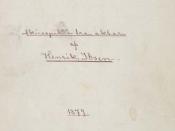In the play "A Dolls House", by Henrik Ibsen, a breakthrough author who put critical spotlights on Victorian era morals, and ethics presented in society, the strength of a woman, not common during Ibsen's time, was portrayed realistically. This realistic plot and what was considered an "immoral conclusion" in the 1800s, brought attention to how a woman in those times could rise up against society's standards. Nora Helmer, the protagonist in this play, is married to an oppressive lawyer, Torvald Helmer, who patronizes her, and treats her like a child throughout the play. The theme in this play is that Nora rises up against the oppression and patronization when she understands her true strength, which has always been inside of her. The author portrays Nora's hidden strength through the following ways:
1) Manipulation, and flirtation;
2) Her gradual growth as a person, from infancy all the way into adulthood; and
3) The final self-actualization which she achieves at the end of the play.
The first method the author used to convey the idea of Nora's strength is in the introduction of A Dolls House, Nora is described as a childish, whiny, and needy woman - what was considered the ideal or typical "Victorian Woman." These traits allow her to be manipulative in order to get something she wants, because she exploits these stereotypes. In the beginning of the story, Nora walks in with shopping bags from Christmas shopping, and a dreaded bag of macaroons, the kind she's not allowed to eat. Even though she's not allowed to eat them, she lies to her beloved husband, who questions her little "squanderbird" if she has "digressed into the pastry shop" (174) when he smells candy on her breath, where she replies that she "could never act against [Torvald's] wishes" (175), even...


